Blurred Borders - International Community Foundation
Blurred Borders - International Community Foundation
Blurred Borders - International Community Foundation
You also want an ePaper? Increase the reach of your titles
YUMPU automatically turns print PDFs into web optimized ePapers that Google loves.
However, for many, securing a place to live is a challenge: one study suggests that Tijuana has<br />
housing shortage of as many as 50,000 units. 102 Even when one can find a place to live, the<br />
quality of affordable housing in Tijuana can be quite low. According to Tijuana’s planning<br />
agency, IMPLAN, approximately half of the urbanized area in Tijuana originated as squatter<br />
settlements. Some squatter settlements have been regulated and basic infrastructure has been<br />
provided, but about 30-40% of the area remains squatter housing without proper title and<br />
without basic infrastructure such as electricity, potable water, and sewage. 103 By one estimate,<br />
about 60% of Tijuana’s urban development is taking place on former ejidos (communal lands<br />
used for agriculture or grazing) that are rapidly being privatized to accommodate new housing<br />
units, “many with substandard infrastructure and communal amenities.” 104<br />
Land shortage has created tension that has in some occasions led to direct occupation of<br />
federal lands. CORETT (Comisión para la Regulación de la Tenencia de la Tierra) is the federal<br />
agency in charge of regulating land. Some occupied lands are legalized through the CORETT,<br />
and, once they are legalized, have rights to the public services. The occupied lands that are not<br />
legalized do not receive any public service such as electricity and sewage, or paved roads. In<br />
Baja California, a state agency, Immobiliaria Estatal, is responsible for buying up vacant land and<br />
making it available to poor residents for housing. However, critics argue that the agency sets<br />
prices that are too high and charge high interest rates. 105 For many workers, their income is<br />
too low to qualify for a housing loan. 106 Fundación Esperanza is a Tijuana non-profit<br />
organization that operates community-based loans funds to finance self-help home building and<br />
renovation. The loan funds have had great success, but are very small in scale.<br />
In contrast to the squatter communities that characterize Tijuana’s hillsides, in the coastal area,<br />
affluent and middle class U.S. citizens are purchasing an increasing number of well-appointed<br />
homes. These U.S. citizens are attracted to Baja California for the lower costs of homes, as<br />
well as for affordability of amenities such as servants, life style and beachfront locations. 107 In<br />
other areas of Baja California, too, the lower cost of housing is attracting U.S. citizens to the<br />
south of the border: according to SANDAG, the cost of a 710-square foot, two-bedroom, onebathroom<br />
home in Tijuana cost about $26,000, compared to the median house price of<br />
$312,000 in San Diego in 2001. 108<br />
102 “Sustainable Urban system Design for Greater San Diego-Tijuana Binational Metropolitan Region,” p. 10.<br />
103 The City of Tijuana and the State of Baja California are working proactively to prevent the creation of colonias<br />
populares and have successfully stopped 14 land invasions in 2001-2002. They are also working to relocate up to<br />
1,000 people that are currently in communities that are in high risk zones that are vulnerable to flooding and<br />
landslides. Source: Sandra Dibble, “Evictions on Tijuana hill turn messy Outcry follows; critics question city's<br />
motives,” San Diego Union Tribune, August 21, 2002, B1<br />
104<br />
“Sustainable Urban system Design for Greater San Diego-Tijuana Binational Metropolitan Region,” p. 10.<br />
105<br />
Information obtained from Mexican Labor News and Analysis 7(1), January 2001. “Baja Police Arrest Mexican<br />
Housing Activists,” by David Bacon.<br />
106<br />
A comment from Carlos Graizbord, June 2002.<br />
107<br />
Rey, et.al (1998), 137.<br />
108<br />
SANDAG (2003), Regional Comprehensive Plan, p. 175.<br />
43















